Because They Are Fast Easy to Use and Accurate for Weighing Diamonds Most Jewelers Use
If you're not familiar with a diamond's structure and components, you may be led to think that a gemstone is a diamond when it's an entirely different stone—like cubic zirconia or moissanite. For this reason it's essential to know how to spot a fake diamond.
This guide is useful and practical yet no single at-home test should be regarded as conclusive. A diamond expert has the proper experience and equipment to confirm if a diamond is real or fake.
Here's what we'll cover in this article:
What to look out for to make sure your diamond is real
How can I tell if a diamond is real at home?
Expert ways to test if a diamond is real or fake
How to test if a diamond is synthetic?
Best practices to ensure you buy a real diamond
MORE:The Best Place to Buy a Real Diamond Engagement Ring

Think You're A Diamond Pro?
Both of these are advertised as 1.0 Carat
D Color diamonds.
One is real and costs $8,820
One is Moissanite and costs $175
Can you tell which is the real diamond?
Here is How to Tell if a Diamond is Real or Fake
1) Water Test
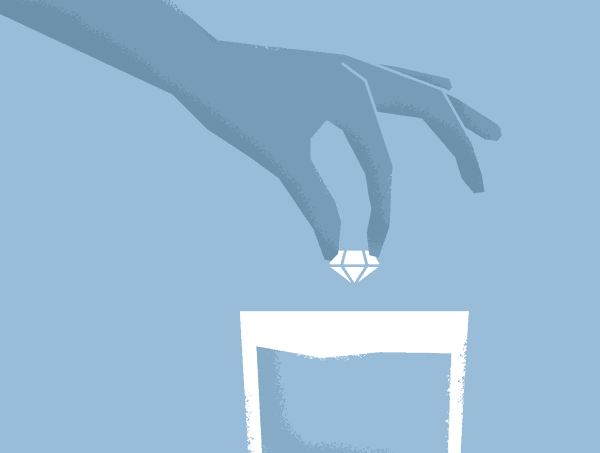
Use this simple test to ensure a diamond is real.
Find a normal sized drinking glass and fill it ¾ of the way with water. Carefully drop the loose stone into the glass. If the gemstone sinks, it's a real diamond. If it floats underneath or at the surface of the water, you have a fake on your hands. A real diamond has high density, so the water test shows if your stone matches this level of density.
2) Fog Test
For the fog test, hold the diamond or ring between two fingers and breath on it with a puff of air. A light fog will form on the diamond because of the moisture and heat in your breath. If the fog dissipates right away, the diamond is real. If it takes several seconds for the fog to disperse, it is likely a fake diamond. Diamonds effectively conduct heat and therefore disperse heat quickly.
3) Check Setting & Mount
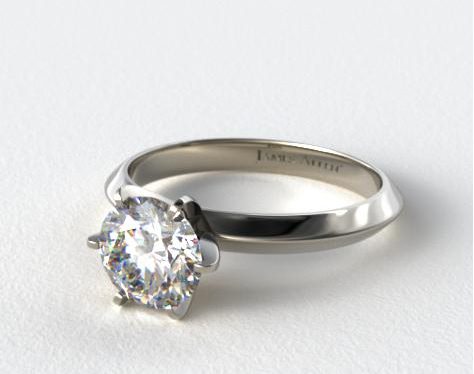
If a diamond is already placed in a ring, look at the type of setting and mount that's used.
Because of a diamond's large price tag, a real one will only be set in high quality jewelry. For example, a real diamond will be set in materials such as white gold, platinum, yellow gold, pave or side-stone setting and halo setting rings.
To see if the setting is truly as described, look inside the ring's center for markings. As an example, the notes 10K, 14K, and 18K indicate the type of gold used. The markings PT and Plat refer to platinum. If you see a number such as 585, 770, 900, and 950, those are markings indicate platinum or gold as well.
If you see a "C.Z." stamp or engraving, the gemstone is a cubic zirconia, and not a real diamond.
4) Heat the Stone and See if it Shatters
Diamonds are made of incredibly strong material and will be unresponsive to high heat.
To test if a diamond is real using heat, grab a drinking glass and fill it with cold water. Use a set of plyers or fireproof gloves to hold the stone. Heat the stone with a lighter for approximately 40 seconds, then drop the stone directly into the cold water. If the stone shatters, it is made of weaker components and is not a real diamond. A true diamond will show no reaction.
The heat test tests the quality and strength of the stone. Because of the quick expansion and contraction of heat, weak materials like glass or cubic zirconium will crack and break. Think of a glass or Pyrex dish you use for cooking. If you pull the dish out of a hot oven and try to wash it immediately, the shock in temperature change may shatter the dish.
Because diamonds are one of the strongest materials on the planet, it will be resistant to such heat tests. Heat will disperse quickly and the diamond won't be affected by the change in temperature.
5) UV Light Test
To test if a diamond is real in a different way, place it under a UV light and watch the reaction. Most diamonds will emit a blue colored glow, but not all of them. Some diamonds do not glow under UV light. For this reason, if the stone does not glow, the results don't necessarily indicate that it's a fake diamond.
Because this test is not definitive, it's best to have a diamond expert or jeweler use their advanced equipment to test the stone.
Test a Diamond At-Home Using Refractivity
When you see a diamond sparkle, you're experiencing its ability to bend and refract light. When light strikes the pavilions (the angled surfaces on the lower half of the diamond), it is bounced and refracted up through the diamond's table (the top, flat surface) to the naked eye. When a diamond does this well and sparkles radiantly, it is called brilliance.
Stones that are not diamonds, such as Cubic Zirconia, will not refract light as well. They will have less brilliance, if any at all.
To test a diamond's refractivity, use the following tests.
6) Newspaper/'Read-Through' Effect
To test the diamond's refractivity, gently place the stone flat side down onto a page of newspaper in an area with lots of lettering. Ensure the lighting is bright and that no objects or people are casting a shadow on the diamond.
If you're able to read the letters of the newspaper—even if the letters are a bit blurry—the diamond is fake. If the diamond is real, its facets will refract the light in different directions, rather than in a straight line. Because of this refraction of light, you won't be able to see clearly through the diamond and make out the letters on the paper.
The newspaper test is most effectively used on loose diamonds. If the diamond is in its setting already, consider using the fog test or having it reviewed by a diamond expert.
7) The Dot Test
If you don't have newspaper to use, the dot test is an excellent alternative.
Place a white piece of paper on a flat surface and draw a small dot with a pen. Lay the stone onto the dot with the flat side down. Through the pointed end of the diamond, look down onto the paper. If you see a circular reflection inside the gemstone, the stone is fake. If you cannot see the dot or a reflection in the stone, then the diamond is real.
Because a true diamond has powerful refractive qualities, light will bounce in different directions instead of a straight line. This is why you won't be able to see letters or dots through a natural, real diamond.
Test a Diamond At-Home Using Reflectivity
In addition to refractivity, you can test a stone based on its reflectivity. While refractivity pertains to the directions the light bounces, reflectivity refers to the amount and quality of the light that is reflected off of the stone.
Reflectivity encompasses both the brilliance (white light sparkle) and fire (colored light) that shines off of a diamond's table.
8) Sparkle Test
The sparkle test doesn't require any equipment—except for your eyes. Hold the diamond in question under a normal lamp. Watch how light reflects off of the stone. Do you see bright shimmers of white light bouncing off the diamond? Do you see colorful light reflections as well?
A real diamond reflects white light extremely well, providing exceptional sparkle. Diamonds also reflect colored light, or fire, in magnificent fashion.
If you compare a real diamond to a fake diamond like Cubic Zirconia, you are able to notice a drastic difference in the white and colored light sparkle that the real diamond gives off.
Expert Techniques To Ensure a Diamond is Real
While various tests can be used to tell if a diamond is real, it's advised to have a professional diamond expert assist you in determining if a diamond is genuine. A professional gemologist who has a Graduate Gemologist (GG) degree will be able to tell you definitively if a diamond is real or not.
Bringing your stone to a diamond professional will give you peace of mind, because several proven methods and tools are used to determine if a diamond is real.
9) Inspecting a Diamond with a Loupe
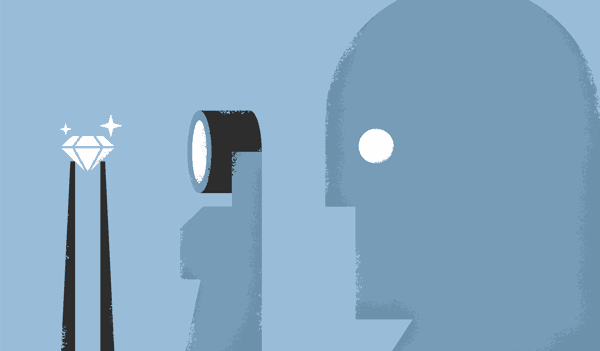
A diamond professional will have access to a loupe—a special magnifying glass used for diamonds, gemstones and jewelry. When using a loupe, a professional will look for blemishes and imperfections within the diamond. While a fake diamond can be perfectly constructed, a diamond will have small imperfections called inclusions.
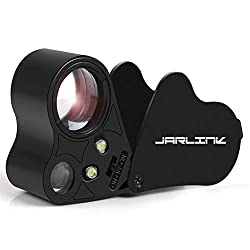
10) Using A Thermal Conductivity Probe (aka "The Diamond Tester")
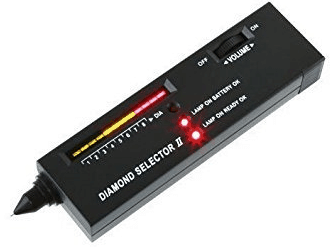
In addition to a loupe, gemologists usually have a thermal conductivity probe or meter. They'll use this tool to determine the thermal conductivity of a gemstone. Because diamonds are effective heat conductors, the diamond will disperse heat rapidly after being warmed.
If the gemstone disperses heat at a slower rate, the diamond is not real. It's worth noting that synthetic moissanite stones often have similar or equal heat dispersement as real diamonds—making this test inconclusive with moissanites. There are many diamond testers available out there, so you can choose whichever one you like the most. Check out an example from Amazon on the right.
11) Testing a Real Diamond with High Profile Weighing
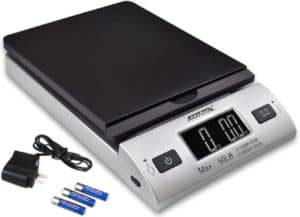
Jewelers and gemologists usually have a very fine tuned scale for measuring small differences in weight. The weight of a real diamond will be lower than fake stones like the Cubic Zirconia—but only special scales for weighing Carats will be able to detect these minute differences.
To perform the test, choose a fake diamond that is approximately equal in shape and size. Use this stone as a comparison for the diamond you are considering.
12) Spot a Fake Diamond Using Electricity Conductivity
Detecting a fake diamond can also be achieved through a electricity conductivity test performed by a jeweler or gemologist. Diamonds conduct electricity better than other stones, including the difficult synthetic moissanite.
An electricity tester will provide a clear sign as to whether or not the stone is real or created by a lab. A diamond will show conductivity while other stones like moissanite and cubic zirconia will not.
Testing A Real Diamond Vs. Moissanite
Because of the increasing presence of synthetic moissanite on the market, it's important to use the tools of a jeweler to test for genuinity. These tools can determine almost immediately if a diamond is real or fake.
13) Examining Using a Microscope
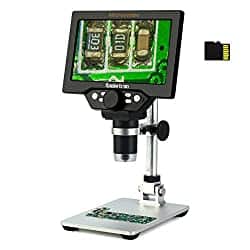
With a 1200x magnification on a power microscope, a jeweler or gemologist is able to scrutinize the stone in detail. At this level of magnification, they'll be able to see inclusions and small differences in real diamonds compared to moissanite.
14) Get an x-ray examination
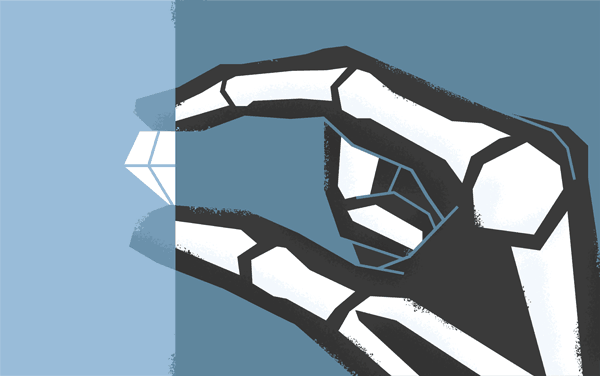
To have the internal, molecular qualities of a stone reviewed, send it to a professional diamond lab for testing. Their x-ray machines will be able to tell if the stone has a radiolucent molecular structure or a radiopaque molecular structure. Diamonds are radiolucent while fakes like cubic zirconium and crystals have more radiopaque features.
Is the Scratch Test Reliable To Ensure a Diamond is Real?
The scratch test was a once widely used technique that aimed to determine the hardness of a gemstone's mineral. The test involved scraping the loose gemstone along a mirror to see if it would scratch the mirror or the stone.
While a diamond is formed with very strong materials, fakes like cubic zirconia and moissanite are quite durable and scratch-resistant as well. For these reasons, the scratch test is not accurate. You are better served to use other tests such as a thermal conductivity test or having the diamond inspected with a professional loupe tool.
How To Spot Other Stones That Aren't Real Diamonds
With the rising popularity in other gemstones, here are some steps to spotting a stone that to the naked eye may appear similar to a real diamond.
15) How to Recognize Synthetic Diamonds
With an increasing prevalence of synthetic diamonds, it's important to know how to tell the difference between lab-created diamonds and natural diamonds. Synthetic diamonds have similar chemical and molecular components to real, natural diamonds.
Because of their intricate internal qualities, we recommend having the diamond reviewed by an expert. They can run the conductivity test and look at the stone under high magnification. Even when it's unclear to the naked eye how a synthetic diamond differs from a natural diamond, it is crucial for resale and insurance values.
16) How to Recognize Cubic Zirconia
A cubic zirconia is one of the easier fake diamonds to test for authenticity. By using the sparkle test, for example, it's relatively easily gauge the amount of sparkle and fire a stone is giving off.
In addition, cubic zirconias reflect orange tinted light. They also weigh more than a real diamond and generally don't have imperfections or inclusions. Real diamonds will have inclusions that can be seen by the naked eye or under a diamond expert's microscope.
17) How to Recognize White Sapphire
Sapphires are commonly available in blue and a wide range of colors including white, which looks clear to the naked eye. White sapphires are often posed as diamonds but don't offer the diamond's signature sparkle and contrast of dark and light areas.
If the stone seems more blurred in coloring—meaning it doesn't have distinct light and dark parts—it is likely to be a white sapphire.
18) How to Recognize Moissanite
Perhaps the best actor in the fake diamond world is the synthetic moissanite. Distinction between the two is usually difficult for the naked eye and requires the expertise of a diamond professional.
An electricity conductivity test will indicate if the gemstone is a moissanite or a true diamond. Note that the thermal conductivity test is not a valid technique for recognizing moissanite because they have nearly identical thermal conductivity as diamonds.
19) How to Recognize White Topaz
While a white topaz may look like a diamond at first glance, several characteristics separate it from a real diamond.
The exterior is softer than a diamond and is easily scratched by other materials. You can also look closely at a white topaz using magnification to see if there are any scratches on the surface. Diamonds will not have scratches because of their durable composition.
Conclusion
Many of the tests in this guide, like the fog test and the thermal conductivity test, can help determine if a diamond is real.
But due to the number and complexity of synthetic gemstone materials, we recommend consulting a diamond expert or jeweler to review the pieces you already have in your home. These experts are trained in knowing how to spot a fake diamond.
If you're using our diamond education or diamond experts for purchasing a diamond, you'll never have a problem knowing if it's real or not. Any diamond you purchase will come with a legitimate GIA or AGS certificate and all you need to do is ensure the diamond matches the certificate.
Bottom Line Recommendation:
This guide is for people who own jewelry pieces or collections and want to know if they are real. If you have jewelry pieces at home or from ancestors you wish to verify, this guide will provide you with at-home tests along with tests a diamond expert or jeweler can conduct with specialized equipment.
The simplest and most effective way to test a stone to see whether or not it's a diamond is to purchase a relatively cheap diamond tester. Otherwise, you might want to consider a higher-end more expensive tester that can also identify a wider range of diamond alternatives.
If you have further questions, be sure to check out our questions page where we answer common inquiries with honesty and helpful tips.

James Allen James Allen is the leader in online diamond sales. Their imaging technology is the same as inspecting a diamond with a jeweler's loupe. They have the largest exclusive loose diamond inventory online and fantastic prices. They also have the nicest collection of lab created diamonds online. Save 10% off Lab Created Diamonds during limited time sale!
What we love about them:
- No questions asked returns within 30 days of shipment. James Allen will send you a paid shipping label to return the ring.
- Lifetime Warranty
- Free International Shipping
- Free prong tightening, repolishing, rhodium plating and cleaning every 6 months
- Provide insurance appraisals
- One free resizing within 60 days of purchase
- Free ring inscriptions
- Best-in-class high quality imagery of all diamonds in stock
- 24/7 Customer Service
- Best-in-class packaging


Blue Nile [generate_bluenile_links url="https://goto.bluenile.com/c/1323400/504049/8660?u=https%3A%2F%2Fwww.bluenile.com%0A%2F" title="Blue Nile" cta="Blue Nile"] is the largest and most well known internet jewelry seller. They have a very large exclusive online inventory. Their high quality images are catching up to James Allens' and their prices are amazing. Blue Nile have generously offered our readers an exclusive one-time use coupon. [dp-bn-coupon message=" (Click Here to save $100 off $1000 purchase)" type_id="1"]
What we love about them:
- No questions asked returns within 30 days of shipment. Blue Nile will send you a paid shipping label to return the ring.
- Lifetime Warranty
- Free Shipping
- Free prong tightening, repolishing, rhodium plating and cleaning every 6 months
- Provide insurance appraisal
- One free resizing within the first year of purchase
- High quality images of about half of their diamonds
- 24/7 Customer Service
- 100% credit towards future upgrades (must be at least double in value)
- Best in class fulfillment

maddoxidentradmus.blogspot.com
Source: https://www.diamonds.pro/education/how-to-tell-if-diamonds-are-real/

0 Response to "Because They Are Fast Easy to Use and Accurate for Weighing Diamonds Most Jewelers Use"
Post a Comment